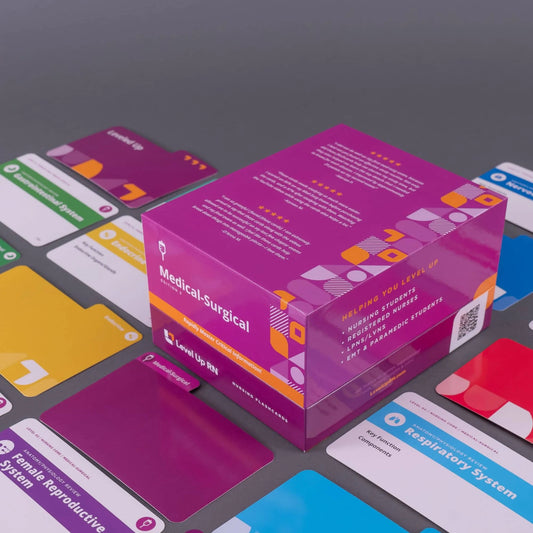Medical-Surgical Nursing - Flashcards
In this article, we’ll explain the heart conduction system, cardiac function, and blood pressure.
The Med-Surg Nursing video series follows along with our Medical-Surgical Nursing Flashcards, which are intended to help RN and PN nursing students study for nursing school exams, including the ATI, HESI, and NCLEX.
Heart Conduction System
In order for the heart to squeeze and pump blood, it needs an electrical impulse. The heart conduction system is known as such because it's the process by which the heart conducts electricity. So, the steps in the heart conduction system are the steps of how the heart transmits its electrical impulse. The sinus node of the heart, which is also known as the SA node, initiates an electrical impulse, which stimulates the atria to depolarize and contract.
This impulse travels down to the AV node, where there is a delay to allow the blood in the atria to empty into the heart's ventricles. Then, the electrical impulse travels to the Bundle of His, then the left and right bundle branches, then to the Purkinje fibers, then to the myocardial contractile cells (ventricular myocardium). Depolarization of the myocardial contractile cells triggers ventricular contraction.
Check out our EKG Interpretation Flashcards for more information.
Cardiac Function
Cardiac function is made up of the cardiac cycle, cardiac output, ventricular ejection fraction, preload and afterload.
Cardiac Cycle
The cardiac cycle is made up of ⅔ diastole and ⅓ systole. Diastole is the relaxation and filling of the atria and ventricle. Systole is contraction and emptying of the atria and ventricles.
Cardiac output
Cardiac output is the volume of blood in liters ejected from the left ventricle each minute. Cardiac output is determined by heart rate, contractility, preload and afterload. A normal cardiac output is 4 - 8 liters per minute.
Cardiac output is the heart rate times stroke volume.
Heart rate is the number of times the ventricles of the heart contract each minute. A normal heart rate is between 60 and 100 beats per minute.
Stroke volume is the volume of blood, in liters, ejected from the left ventricle with each heartbeat.
Decreased vardiac output can be caused by hypovolemia, MI, vasodilation, and heart failure. Increased cardiac output can by caused by sepsis, anemia, and hyperthyroidism.
Check out our Lab Values Flashcards for more information.
Left Ventricular Ejection Fraction (LVEF)
Left ventricular ejection fraction is the percentage of blood that leaves the left ventricle of the heart each time it contracts. A normal level for LVEF is 55 - 70%. Causes of a low LVEF include congestive heart failure, cardiomyopathy, coronary artery disease, myocardial infarction, and valvular heart disease.
These diseases will be covered later in this series, and if you need to study them for your Med-Surg classes or nursing practice, we recommend our Medical-Surgical Nursing Flashcards!
Preload
The preload is the volume of blood in the ventricles of the heart at the end of the diastole (just prior to contraction). The preload determines the amount of stretch placed on myocardial fibers.
Afterload
The afterload is the peripheral resistance the left ventricle of the heart must overcome to push the blood into the systemic circulation.
Blood Pressure
Blood pressure is the force of blood exerted against the arterial walls, and it is made up of systolic and diastolic blood pressure.
Systolic blood pressure
Systolic blood pressure is the amount of pressure generated against the arterial walls during left ventricular systole (contraction of the heart).
Diastolic blood pressure
Diastolic blood pressure is the amount of pressure generated against the arterial walls during left ventricular diastole (relaxation of the heart).
Regulation of blood pressure
The autonomic nervous system controls blood pressure via input from sensory receptors like the baroreceptors, chemoreceptors, and stretch receptors, located in blood vessels near the heart.



3 comments
Hi Kathy ! I appreciate to open up the effective doors for surfing student to get more updating knowledge in simple way ! I met your program recently on IG and I bought all nursing cards recently and I follow up your program ! I do appreciate you again !
Saeed
I thank you so much for all your video’s and Lectures, they are a very big help to me. A student that is just starting nursing school. Your preparing me for all my exams. Thank you
This is WONDERFUL! I am in A&P II right now and this video connects so many dots for me. The amount of information we are taught in these classes is so overwhelming that it’s easy to lose sight of the nuts and bolts. This cuts right to the chase and ties everything together for me. Thank you so much, Cathy! I am so happy I made this investment!